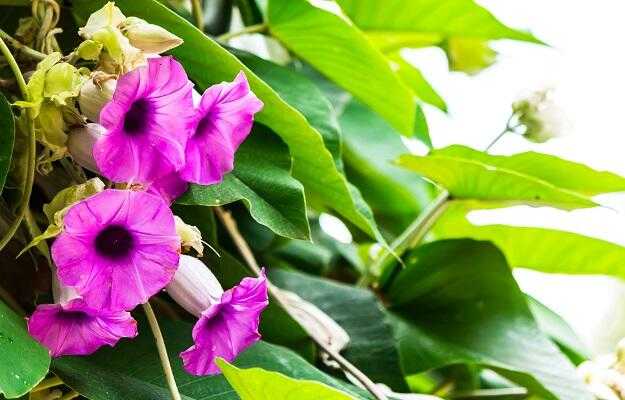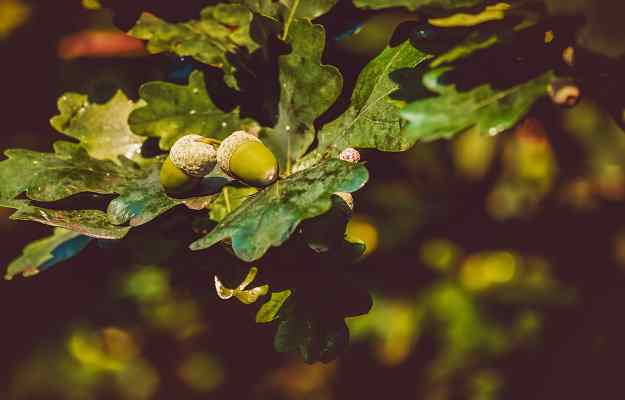Vridhadaru or Argyreia speciosa is a creeper plant that is widely found in the Indian subcontinent and in tropical regions around the world. The plant is used as an ornamental for its distinct purple flowers and is also consumed in some parts of India, especially Bihar and Assam, as a vegetable.
In the Ayurvedic system of medicine, vridhadaru is known as a rasayana or an adaptogen and is used for the treatment of various ailments ranging from neurological and rheumatic disorders to anorexia, diabetes and hypertension. Roots of this plant are used as a health-building tonic. In fact, vridhadaru is an important constituent of various ayurvedic formulations.
However, vridhadaru seeds contain a hallucinogenic compound called lysergamide (LSA) and consumption of these seeds may be fatal when taken in the wrong dosage. The herb is also taken as a contraceptive in certain parts of Rajasthan. It is always best to consult an experienced ayurvedic doctor before taking vridhadaru in any form.
Some facts about Vridhadaru:
- Botanical name: Argyreia speciosa, Arygyreia nervosa
- Family: Convolvulaceae
- Common names: Elephant creeper, Wooly morning glory, Hawaiian baby Woodrose, Silky elephant glory
- Hindi names: Samandar-ka-pat, Ghav-patta, Vidhara, Samundarsokha
- Sanskrit names: Samundrasosha, Antakotarapushpi, Vryddhadaraka or Vridha daraka, Chhagalanghhri
- Parts used: Seeds, leaves, roots and flowers
- Geographical distribution: Vridhadaru grows well in tropical and subtropical areas. It is native to India but is also cultivated in Central and South America, East Asia and the Caribbean. In India, vridhadaru is commonly found in the states of Orrisa, Bihar and Assam along with South India.
- Identifying vidhara or vridhadaru and how do you grow vidhara?
- Vridhadaru (Elephant creeper) health benefits
- Vridhadaru as an aphrodisiac
- Vridhadaru effects on the brain
- Antioxidant, anti-inflammatory and adaptogenic effects of vridhadaru
- Antimicrobial effects of vridhadaru
- Vridhadaru effects on liver
- Vridhadaru benefits in diabetes
- Other health benefits of vridhadaru (elephant creeper)
- Vridhadaru (Elephant creeper) side effects
Identifying vidhara or vridhadaru and how do you grow vidhara?
Vridhadaru mostly grows near river banks and on the edges of lakes (slightly moist areas). However, it does not grow well in wet tropical areas. The plant is also found growing as undergrowth in semideciduous forests.
Initially (for the first two years), the plant grows as a bush. However, later on, it turns into a woody climber. Vridhadary vines are known to grow over 10 meters in height. The plant has broad ovate (in the shape of an egg) leaves — about 20-25 cm broad and 20-30 cm in length — that grow alternately on the stem.
Vridhadaru bears purple to rose coloured flowers that are large and shaped like a funnel and the fruit of this plant is fleshy, round and yellowish-brown in colour. Every fruit bears about four blackish coloured seeds.
The plant can be propagated through seeds or stem cuttings.
Vridhadaru (Elephant creeper) health benefits
Vridhadaru plant is traditionally used for the management of a number of ailment including diarrhoea, dysentery and smallpox. Roots of this plant possess aphrodisiac properties and are also known to be an efficient cardiotonic and brain tonic. Vridhadaru leaves are used by some people to make healing poultice for wounds and for the treatment of skin conditions like eczema, itching and ringworm.
Vridhadaru plant is said to have many other health benefits, some are backed by science while others are still being studied. Following are some of them.
Vridhadaru as an aphrodisiac
Vridhadaru as an aphrodisiac
In the Ayurvedic system of medicine, Vridhadaru is known to be an aphrodisiac. According to a study published in the Journal of Endocrinology and Reproduction, some research records of Ayurvedic practitioners in Kerela suggest that the roots of vridhadaru plant may increase the chances of a male offspring. Studying the effect of the herb on mice, the researchers found that roots, flowers and leaves of the plant possess aphrodisiac properties.
In another study, vridhadaru roots were found to have aphrodisiac and spermatogenic (increased sperm production) effects in mice.
(Read more: How to increase sperm count)
Vridhadaru effects on the brain
Vridhadaru is traditionally known to be a brain tonic. It has the following effects on the nervous system:
- Motor activities: A study done in mice showed that the root extracts of A. nervosa suppress the activity of the central nervous system as well as spontaneous motor activity. Motor activity refers to things we do without even thinking about them. Experts suggest that this drug may have neuroleptic properties, that is it helps reduce nervous tension.
- Nootropic: In an in vivo (animal-based) study, vridhadaru was suggested to have sedative effects on the body along with possible neuroleptic (improve cognition and reduce confusion) properties. A study published in the Journal of Health Science indicated that A. speciosa can reverse age-related amnesia in mice and improve both memory and learning. Another animal study done in Pune, India found improvement in spatial memory and learning skills on regular administration of A. speciosa. (Read more: Home remedies to improve memory)
- Anticonvulsant: Treatment with A. speciosa extract was suggested to be effective in reducing seizures in mice, suggesting the anticonvulsant activity of this herb.
(Read more: How to increase brain power)
Antioxidant, anti-inflammatory and adaptogenic effects of vridhadaru
Vridhadaru is traditionally used for the treatment of inflammatory conditions. Animal studies show that A. speciosa root and leaf extracts have potent anti-inflammatory and analgesic (pain reducing) properties. In one of these studies, vridhadaru leaf extract was suggested to be as effective as the drug aspirin.
According to a study conducted in India, A. speciosa extracts were indicated to have both anti-inflammatory and anti-arthritic effects. In another study, the herb was suggested to possess anti-inflammatory effects. However, it was not found to be effective against arthritis. Arthritis is an inflammatory condition of joints.
A preclinical (conducted on animal models) study published in the Journal of Ayurveda and Integrative medicine found that regular administration of A. speciosa extract can increase the body’s resistance to all kinds of stress, possibly due to stimulation of the immune system.
Antimicrobial effects of vridhadaru
Several studies indicate the antimicrobial effects of A speciosa. Seed oil obtained from vridhadaru plant was found to have a wide range anti-bacterial effect. It was also suggested to be effective against fungi including Aspergillus (causes infections in the respiratory system and ears) and Cryptococcus neoformans (causes meningitis).
In another study, crude extract of vridhadaru plant was indicated to be effective against pathogenic bacteria including Salmonella typhi (causes typhoid fever) and Micrococcus luteus (opportunistic pathogen, causes infections in immunocompromised people).
According to a study published in the Indian Journal of Experimental Biology, A speciosa root extracts can suppress the growth of microbes including Klebsiella pneumoniae (causes pneumonia) and Mycobacterium tuberculosis (causes TB).
Vridhadaru extracts have also shown antiviral activity against vaccinia virus, the causative agent of smallpox.
Vridhadaru effects on liver
Vridhadaru plant is indicated to be effective in preventing liver damage and promote liver health. A preliminary animal-based study done in India suggested that the leaves of A. nervosa plant have hepatoprotective effects and may hence be used as a herbal remedy for the treatment of liver diseases.
In another study, ethanolic extract of vridhadaru roots was found to possess antioxidant properties comparable to that of a liver-protecting herbal formulation called silymarin.
According to a study published in the online journal Drug Intervention Today, A. nervosa root extracts can protect the liver from alcohol-induced liver toxicity.
(Read more: Foods to improve liver health)
However, since there is no clinical evidence to prove the hepatoprotective effects or side effects of vridhadaru on the human liver, it is best that you consult an experienced ayurvedic practitioner before consuming this herb in any form.
Vridhadaru benefits in diabetes
An in-vivo (done on mice) study done in India suggested that consumption of vridhadaru root may be effective in reducing blood glucose levels in healthy as well as diabetics.
A study published in the Journal of Applied and Pharmaceutical Science indicated that the ethanolic extracts of A. speciosa plant possess potent antidiabetic properties that are comparable to those of glibenclamide, an antidiabetic drug.
Topical application (rather than oral consumption) of the leaf extract of A. nervosa was shown to be effective in promoting the healing of diabetic wounds that normally take longer to heal.
Since there is no confirmatory clinical evidence to prove the hypoglycemic (blood sugar reducing) effects of vridhadaru yet, diabetic people should talk to a doctor before trying this herb.
(Read more: Diabetes treatment)
Other health benefits of vridhadaru (elephant creeper)
Apart from the above-mentioned health benefits, here are some other potential benefits and uses of vridhadaru plant:
- In some folk traditions, dried root powder of vridhadaru plant is taken in a ratio of 3:1 with country liquor to manage gonorrhoea.
- Vridhadaru root powder, when taken with milk, is said to be effective in reducing pain during urination.
- The upper surface of vridhadaru leaves is said to promote suppuration (formation of pus) when applied to boils.
- An infusion of vridhadaru roots, when made in goat milk in a 3:1 ratio, is believed to help cure male sexual disorders.
- Roots of vridhadaru plant are consumed by some tribes in eastern India for the treatment of gastrointestinal disorders. In a study done on mice, it was indicated that the ethanolic extracts of A. speciosa flowers may help manage gastric ulcers.
- In a study done in Mumbai, India, A. speciosa was found to stimulate the immune system and increase antibody titer in mice.
- Vridhadaru extracts have been shown to reduce blood cholesterol levels and have anti-obesity effects in mice.
- In another animal-based study, A. speciosa extracts were found to be effective in reducing fever. The authors of the study indicated that this may be due to inhibition of prostaglandin synthesis in the hypothalamus (a part of the brain). Prostaglandins are a type of lipids (fats) that help regulate body temperature.
Vridhadaru (Elephant creeper) side effects
Here are some of the side effects of vridhadaru plant:
- Vridhadaru seeds can be fatal if taken in the wrong dosage.
- Vridhadaru is said to have contraceptive effects. Women are suggested to talk to a doctor before taking this herb.
- A. speciosa is suggested to be hypoglycemic in nature. If you tend to have low blood sugar levels or are taking anti-diabetic medication, try to avoid consuming vridhadaru.
- If you have any chronic health condition or are taking medications for one, it is best to talk to a doctor before consuming vridhadaru.
Find Ayurvedic Doctor in cities
Doctors for Vridhadaru benefits and side effects

Dr. Ayush Bansal
Ayurveda
2 Years of Experience

Dr. Megha Sugandh
Ayurveda
6 Years of Experience

Dr. Nadeem
Ayurveda
3 Years of Experience

Dr.Ashok Pipaliya
Ayurveda
12 Years of Experience
Medicines / Products that contain Vridhadaru (Vidhara)
- Himalaya Confido Tablet Pack of 3 - ₹540
- Baidyanath Nagpur Ashwagandhadi Churna 100gm - ₹148
- Herbal Canada Gas Go Churn - ₹72
- Baidyanath Ashwagandhadi Churna 50gm - ₹85
- Baidyanath Ashwagandhadi Churna 100gm - ₹140
- Panderm + Dusting Powder - ₹141
- Unjha Shakti Sagar Rasa (100) - ₹715
- Unjha Shakti Sagar Rasa (30) - ₹289
- Himalaya Confido Tablet (60) - ₹227
- Himalaya Geriforte Tablet - ₹194
- Himalaya Tentex Forte Tablet - ₹120
- Chetan Sehat Prash (60) - ₹650
- Himalaya Geriforte Syrup - ₹147
- Baidyanath Dhatupaushtik Churna 60gm - ₹149
- Herbal Canada Veerya Paushtic Churan - ₹148
- Baidyanath Dhatupaushtik Churna 50gm - ₹149
- Baidyanath Dhatupaushtik Churna 100gm - ₹242
- Maha Herbals Lipo Peace Tablet - ₹252
- Maha Herbals Ashwagandhadi Churna - ₹76
- Anju Jointex Capsule - ₹240
- Anju AP 31 Capsule - ₹300
- Baidyanath Nagpur Ashwagandhadi Churna 50gm - ₹76
- Hamdard Habbe Nishat - ₹99
- Ultra Healthcare Jointfix Syrup - ₹175
- Tansukh Vidhara Churna - ₹72
- Vyas Vigogem Tablet - ₹280
- Himalaya Tentex Forte Tablet (10) - ₹70
- Ayurveda Yogashram Remedies Sino Heal Capsules (90) - ₹1090
- Himalaya Tentex Forte Tablet Pack of 3 - ₹256
- HempStreet Manmath Ras Tablet (40) - ₹199
- XQUISIT Babassu & Blackseed Hair Oil 100ml - ₹509
- Baidyanath Leucogard Tablet - ₹76
- Deep Ayurveda Ashwagandhadi Churna 100gm - ₹170
- Lama Draksharist - ₹119
References
- Joseph Ancy, Mathew Samuel, Skaria Baby P, Sheeja EC. Medicinal uses and biological activities of Argyreia speciosa Sweet (Hawaiian Baby Woodrose): An Overview. Indian Journal of Natural Products and Resources. 2011; 2(3).
- Galani V. J., Patel B. G., Patel N. B. Argyreia speciosa (Linn. f.) sweet: A comprehensive review. Pharmacogn Rev. 2010 Jul-Dec; 4(8): 172–178. PMID: 22228958.
- Meher Ashutosh, Kumar A. Anuji, Ranjan Padhan Amiya. A Literature review on Argyreia nervosa (Burm. F.) Bojer. International Journal of Research in Ayurveda and Pharmacy. 2011 May. 2(5):1501-1504.
- CABI: Centre for Agriculture and Bioscience International [Internet]. Wallingford. UK; Argyreia nervosa (elephant creeper)
- Modi Ashish J., Khadabadi S. S., Farooqui I.A., Deore S.L. Argyreia speciosa Linn.F. : Phytochemistry, Pharmacognosy and Pharmacological studies. International Journal of Pharmaceutical Sciences Review and Research. 2010; 2(2): 14-21.
- Subramoniam A., Madhavachandran V., Ravi K., Anuja V.S. Aphrodisiac property of the elephant creeper Argyreia nervosa. J Endocrinol Reprod. 2007; 2: 82-85.
- Vyas Niraj, Raval Manan. Aphrodisiac & Spermatogenic Potential of Alkaloidal fraction of Argyreia speciosa Linn. in Rats. eposters. 2014.
- Galani VJ, Patel BG. Psychotropic activity of Argyreia speciosa roots in experimental animals. Ayu. 2011 Jul;32(3):380-4. PMID: 22529655.
- Joshi Hanumanthachar, Kaur Navneet, Chauhan Jyotibala. Evaluation of Nootropic Effect of Argyreia speciosa in Mice. Journal of Health Science. 2007; 53(4):382-388.
- Vyawahare N. S., Bodhankar S. L. Anticonvulsant Activity of Argyreia speciosa in Mice. Indian J Pharm Sci. 2009 Mar-Apr; 71(2): 131–134. PMID: 20336209.
- Bachhav RS, Gulecha VS, Upasani CD. Analgesic and anti-inflammatory activity of Argyreia speciosa root. Indian J Pharmacol. 2009 Aug;41(4):158-61. PMID: 20523865.
- Gokhale AB, Damre AS, Kulkami KR, Saraf MN. Preliminary evaluation of anti-inflammatory and anti-arthritic activity of S. lappa, A. speciosa and A. aspera. Phytomedicine. 2002 Jul;9(5):433-7. PMID: 12222664.
- Patel Nikunj B., Galani Varsha J., Patel Bharatkumar G. Antistress activity of Argyreia speciosa roots in experimental animals. J Ayurveda Integr Med. 2011 Jul-Sep; 2(3): 129–136. PMID: 22022155.
- Habbu PV, Mahadevan KM, Shastry RA, Manjunatha H. Antimicrobial activity of flavanoid sulphates and other fractions of Argyreia speciosa (Burm.f) Boj. Indian J Exp Biol. 2009 Feb;47(2):121-8. PMID: 19374167.
- Habbu PV, et al. Hepatoprotective and Antioxidant Effects of Argyreia Speciosa in Rats. Afr J Tradit Complement Altern Med. 2008; 5(2): 158–164. PMID: 20161932.
- Geetharani K. S., Vijayakumar R., Shanmugasundaram M., Selvaraj J. Effect of Argyreia nervosa on liver function markers in alcohol-induced male albino rats. Drug invention today. 2020; 11(9): 2265-2269.
- Geetharani K. S., Vijayakumar R., Shanmugasundaram M., Selvaraj J. Argyreia nervosa reduces alcohol-induced altered levels of oxidative stress in the liver Wistar male albino rats. Drug invention today. 2020; 13(1): 134-139.
- Kooti Wesam, et al. The role of medicinal plants in the treatment of diabetes: a systematic review. Electron Physician. 2016 Jan; 8(1): 1832–1842. PMID: 26955456.
- Gokhale AB, Damre AS, Saraf MN. Investigations into the immunomodulatory activity of Argyreia speciosa. J Ethnopharmacol. 2003 Jan;84(1):109-14. PMID: 12499085.
- Ali S.A., et al. Chemical constituents of Argyreia speciosa Fam. Convolvulaceae and its role against hyperglycemia. Journal of Applied Pharmaceutical Science. 2011; 01(08): 76-84.
- Singhal A, Gupta H, Bhati V. Wound healing activity of Argyreia nervosa leaves extract. Int J Appl Basic Med Res. 2011 Jan;1(1):36-9. PMID: 23776770.
- Unadkat K.P., Jani D.K., Pandey R.C. Comparative Study of Various Pharmacological Screening of Argyreia speciosa Sweet. In Relation with Ayurvedic Documented Literature. Asian Journal of Pharmaceutical Research and Development. 2019; 7(5): 38-42.












